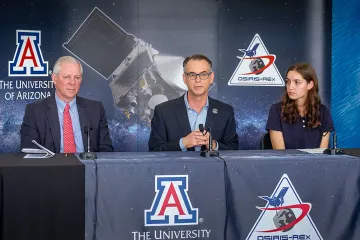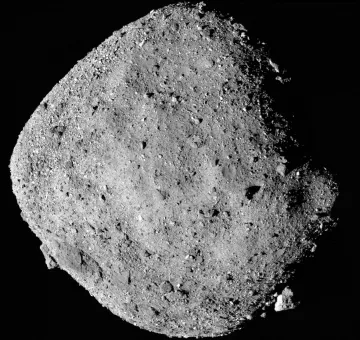OSIRIS-REx Arrives at Bennu
Since its launch on Sept. 8, 2016, OSIRIS-REx has spent two and a half years catching up with asteroid Bennu on its orbit around the sun. The spacecraft’s arrival at Bennu on Dec. 3, 2018, marked a major milestone, with the mission transitioning from flying toward the asteroid to orbiting around it.

From left: UA President Robert C. Robbins, OSIRIS-REx principal investigator Dante Lauretta and UA senior Keara Burke, an image-processing intern on the mission / Bob Demers/UA News photo
NASA’s OSIRIS-REx spacecraft arrived at its destination, asteroid Bennu, on Dec. 3. Led by the University of Arizona, the OSIRIS-REx mission is the first NASA mission to visit a near-Earth asteroid, survey the surface, collect a sample and deliver it safely back to Earth. The composition of the asteroid could shed more light on the origins of the solar system.
“Initial data from the approach phase show this object to have exceptional scientific value. We can’t wait to get to work studying and characterizing Bennu’s rough and rugged surface to find out where the right spot is to collect the sample and bring it back to Earth,” says Dante Lauretta, the mission’s principal investigator. “The true nail-biting moment will be the sample collection. The best times are ahead of us, so stay tuned. The exploration of Bennu has just begun, and we have a lifetime of adventure ahead of us.”
OSIRIS-REx spent the next month performing flybys of Bennu’s north pole, equator and south pole, at distances between 11.8 and 4.4 miles from the asteroid. These maneuvers allowed for the first direct measurement of Bennu’s mass as well as close-up observations of the surface. The trajectories also provided the mission’s navigation team with experience navigating near the asteroid.
The spacecraft will spend a year and a half extensively surveying the asteroid before the mission team identifies two possible sample sites. The spacecraft will study the asteroid with various instruments, providing mission scientists with a wealth of data about the asteroid’s exact shape and chemical composition and the physical properties influencing how it is affected by the sun and the surrounding space.

This mosaic image of the asteroid Bennu is composed of 12 PolyCam images collected on Dec. 2 by OSIRIS-REx from a range of 15 miles.
Sample collection is scheduled for July 2020, when OSIRIS-REx will touch the surface for five seconds to gather a sample of the asteroid. The spacecraft will head back toward Earth before ejecting the Sample Return Capsule for landing in the Utah desert on Sept. 24, 2023.
“Working on this mission has been probably the most life-changing event that has happened to me so far,” says UA senior Keara Burke, a systems engineering and mathematics double major who is helping the mission team find the perfect place to collect samples.
“It’s incredible to be able go to work every day and know that what I’m contributing to the conversation matters. Being able to be part of this type of mission — I don’t think I would have gotten this opportunity anywhere else.”
The UA leads the OSIRIS-REx mission on behalf of NASA. All science operations of the mission are housed at and led by the UA’s Lunar and Planetary Laboratory, where all science data gathered by the spacecraft are received and analyzed. More than 150 students, including undergraduates and graduate students, have been working on the mission.
“It is really exciting to arrive at the asteroid that our team has been tracking now for a couple of years and to see one of our students being so intimately involved in this project,” UA President Robert C. Robbins says of Burke. “I think this highlights the fact that we are the place that not only does this kind of research but also educates the next generations of leaders in this field.”
OSIRIS-REx stands for Origins, Spectral Interpretation, Resource Identification, Security-Regolith Explorer. The economic impact to Arizona of the OSIRIS-REx mission is $230.5 million. Of that, $172.3 million comes to Tucson.
